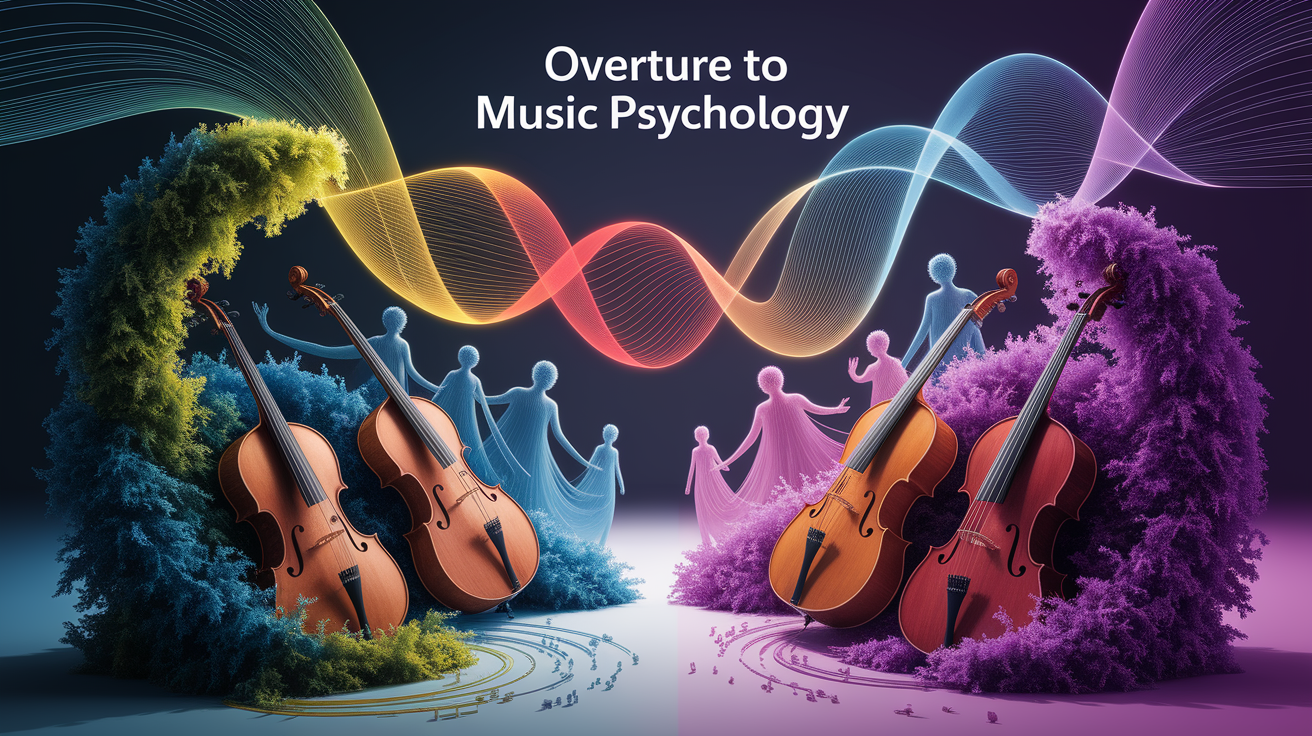Music Psychology Unveiled: How Music Shapes Your Mind
Overture to Music Psychology
From the anthems that galvanize stadiums to the lullabies that soothe us to sleep, music is a universal thread woven into the fabric of human experience. But what is it about a sequence of notes, rhythms, and harmonies that can profoundly alter our mood, sharpen our focus, or transport us back in time? The answer lies in the fascinating field of music psychology. At its core, music psychology is a multidisciplinary science dedicated to understanding musical behavior and experience. It explores the intricate processes involved in creating, perceiving, and responding to music, integrating insights from cognitive psychology, neuroscience, music theory, and sociology.

This field seeks to answer fundamental questions: How do we process sound into meaningful musical structures? Why does a particular melody evoke a powerful emotional response? What cognitive mechanisms are at play when we learn an instrument? By examining these questions, music psychology not only deepens our appreciation for art but also provides profound insights into the broader landscape of human behavior and mental processes, revealing the powerful and often subconscious ways music shapes our minds.
Foundations and Evolution
While the formal discipline is relatively modern, the inquiry into music’s power is ancient. Philosophers in classical Greece debated the ethical and emotional effects of different musical modes. However, the field gained significant momentum in the sixteenth and seventeenth centuries, with Enlightenment thinkers like Sir Francis Bacon and John Locke exploring music’s emotional and cognitive impacts. It was during this period that the focus shifted from mystical speculation to more systematic observation.

The emergence of music psychology as a distinct scientific discipline in the mid-twentieth century marked a pivotal turning point. Armed with new research methodologies, psychologists began to systematically study everything from musical aptitude and performance anxiety to the developmental role of music in childhood. This evolution has led to a much richer, evidence-based understanding of how music is created, perceived, and applied across countless human contexts, highlighting its practical relevance in our daily lives.
How Music Impacts the Mind and Body
Music’s influence is not merely an abstract emotional experience; it produces tangible physiological and neurological changes. When sound waves enter the ear, they are converted into electrical signals that travel to the brainstem, which deciphers basic elements like pitch and rhythm. From there, the signals engage complex networks across the brain, including the auditory cortex for processing sound, the limbic system for emotions, and the prefrontal cortex for memory and expectation.
The Emotional Brain on Music
Perhaps music’s most celebrated effect is its power over our feelings. The reason certain songs can make us feel euphoric, nostalgic, or somber is that music directly taps into the brain’s reward and emotion centers, like the amygdala and the nucleus accumbens. Listening to pleasurable music can trigger a release of dopamine, the same neurotransmitter associated with food, love, and other rewarding experiences. This neurological event is central to the science of our inner emotional world, explaining why music is such a potent tool for mood regulation. Whether we choose an upbeat playlist to get motivated or a melancholic tune for catharsis, we are engaging in a sophisticated form of emotional self-management.
Cognitive Enhancement and Memory Formation
Can music make you smarter? While the “Mozart effect” has been largely simplified by popular culture, research does confirm significant cognitive benefits of music. For instance, listening to background music, particularly instrumental or classical pieces, can improve focus and performance on certain tasks. The benefits of listening to classical music for studying are often attributed to its ability to create a stimulating yet non-distracting auditory environment.

Furthermore, the connection between music and memory formation is exceptionally strong. This is why a song from your teenage years can instantly evoke vivid memories and feelings. This phenomenon, known as musically-evoked autobiographical memory (MEAM), occurs because music activates a wide network of brain regions, including the hippocampus (a key memory hub) and the prefrontal cortex. Training in music has an even more profound impact, as it can induce long-term brain changes. Learning an instrument has been shown to enhance neuroplasticity for rehabilitation and cognitive skills by strengthening connections between the brain’s hemispheres and improving executive functions like planning and problem-solving.
Physical Well-being and Stress Reduction
The mind-body connection is powerfully illustrated by music’s effect on our physical state. Slow, quiet music can lower heart rate, blood pressure, and levels of the stress hormone cortisol, making it an effective tool for anxiety relief and relaxation. This demonstrates the interconnectedness of mind and body in health psychology, where psychological inputs like music directly influence physiological health. Athletes often use fast-paced, high-tempo music to increase physical arousal and endurance, showcasing music’s ability to modulate our energy and performance.
Practical Applications in Real Life
The insights gleaned from music psychology are not confined to the laboratory. They have wide-ranging applications that touch numerous aspects of society, from healthcare to marketing.

- Music Education: Understanding how children develop musical skills helps educators design more effective curricula. It informs teaching methods that cater to varying levels of musical aptitude and learning styles.
- Music Performance and Composition: Performers use psychological strategies to manage performance anxiety and enter a state of “flow.” Composers and songwriters, consciously or not, manipulate musical elements like tempo, harmony, and rhythm to elicit specific emotional responses, drawing on principles that music psychology explains. This creative process shares similarities with other fields that explore psychological strategies for innovative thinking.
- Consumer Behavior: In retail and marketing, “sonic branding” uses music to shape consumer perceptions and influence purchasing decisions. The tempo of background music in a store can affect the pace at which people shop, and the choice of genre can reinforce a brand’s identity.
- Music Therapy: One of the most significant applications is in music therapy, a clinical, evidence-based practice. Therapists use music to address physical, emotional, cognitive, and social needs. For example, rhythmic entrainment can help patients with Parkinson’s disease improve their gait, while songwriting can provide an expressive outlet for individuals dealing with trauma or depression. Specific programs have been developed to use music as part of treatment for conditions like post-traumatic stress disorder.
Methods Behind the Music
To uncover the psychological effects of listening to music, researchers employ a diverse toolkit of scientific methods. These techniques allow for objective measurement of how the brain and body respond to musical stimuli, moving beyond anecdotal evidence.

- Experiments and Surveys: Controlled experiments are often used to compare the effects of different types of music on variables like cognitive performance, mood, or stress levels. Surveys and questionnaires help gather data on musical preferences, listening habits, and the social contexts of music.
- Brain Imaging: Technologies like functional magnetic resonance imaging (fMRI) and electroencephalography (EEG) allow researchers to observe the brain in real-time. This provides a window into how the brain processes sound and which neural circuits are activated by melody, rhythm, and harmony. For instance, fMRI studies can show dopamine release in the brain’s reward centers when a participant hears a particularly moving piece of music.
- Psychoacoustic Measurements: This method focuses on the relationship between the physical properties of sound (like frequency and amplitude) and their psychological perception (like pitch and loudness). These methods and techniques help explain why certain combinations of sounds are perceived as consonant and pleasing, while others are dissonant and jarring. These methods are crucial for understanding the mechanisms underlying music perception and its effects on human behavior.
Grand Finale: Your Musical Mind
Music psychology reveals that our connection to music is a fundamental aspect of our cognitive and emotional lives. It is a powerful force that can heal, motivate, and connect us. From its deep historical roots to its modern applications in therapy and education, the study of music and the mind continuously unveils how a simple arrangement of sounds can shape our brains, regulate our feelings, and enrich our existence.
By understanding the science behind why music makes us feel, you can begin to use it more intentionally in your own life. Consider curating playlists not just based on genre, but on function—a soundtrack for focus, a collection for stress relief, or an album to accompany a reflective moment. Your musical mind is a powerful and responsive instrument; learning how to play it is one of the most rewarding journeys you can take.







